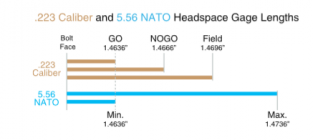hoz53
Gold $$ Contributor
nothing new for an AR to push the shoulder back some. Ive had it happen to me.i am sizing brass to the bolt gun . the trying it in AR was to find if the same sizing of the brass was going to work in the AR. then try'ed a factory loaded one ,the AR set it back .003
here i am loading some 223, bolt gun. i checked to sure that i had the die set correctly . i sized a case and slipped the brass into the chamber , needed just a bit more force on the bolt handle than it should take . then adjusted the die for perfect fit . removed and measured the brass at the shoulder and slipped it into an AR carefully closing .worked as it should . removed the brass, remeasured it, its was the same . put it back into chamber and did a free drop of the bcg as hard as it would go . removed the brass and it had shortened .007 ......i'm confused












